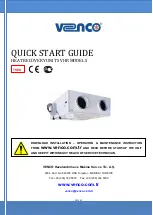
Design Guide for Hazardous / Industrial
Self-regulating trace heating systems
21-5400-7D0001/-
05/2023-EHT-466854
Notice Technical data subject to change without notice.
No claims for damage arising from alternations, errors or misprints shall be allowed.
Page 8 / 40
System design
For the design of trace heating systems with BARTEC self-regulating trace heaters, the following steps are necessary:
Trace heater selection
Determination of the total required trace heater length
Determination of the required number of trace heating circuits
Selection of the required components and accessories for power connection, control and monitoring, end termination etc.
The following sections provide step-by-step instructions on how to proceed with each step.
Trace heater selection
Step 1: Familiarize yourself with the trace heater types and their properties
BARTEC self-regulating trace heaters are available in various types to suit different applications. Each trace heater is marked with a product code
that contains relevant information as shown in the following example for trace heater PSB:
Trace heater family
PSB (07-5853)
MSB (07-5854)
Trace heater output
in W/m @ 10 °C
Outer jacket
CT(F) = fluoropolymer
CR (P) = polyolefin
Voltage rating
1 = 120 Vac
2 = 277 Vac
Trace heater output in W/ft @ 10 °C
→ Example
A trace heater that bears the marking 10PSB2-CT...PSB33...Type 07-5853-733F has the following specifications:
Trace heater output @ 10 °C: 33 W/m (10 W/ft)
Trace heater family: PSB
Voltage rating: 230 Vac
Outer jacket: fluoropolymer
Step 2: Determine the heat loss of your pipe setup
For proper system design it is essential to know the effective heat loss of your pipe setup. To determine it, the following data will be required:
Pipe diameter
Insulation thickness
Insulation material
Maintain temperature
Minimum ambient temperature
Temperature differential ΔT: ΔT = maintain temperature - minimum ambient temperature
BARTEC
®
10PSB2-CT...PSB33...Type 07-5853-733F
pipe diameter
insulation thickness
minimum
ambient temperature
maintain
temperature











































